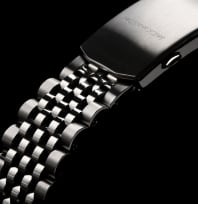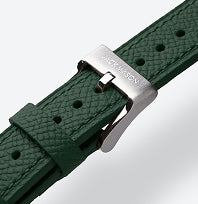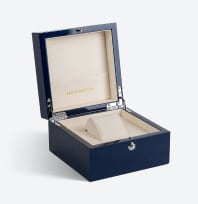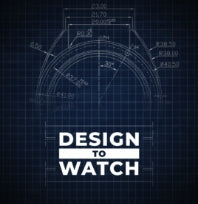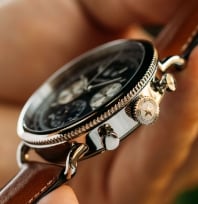In the beginning, there were no watches. Humans relied on the sun to tell the time, originally just by looking up and interpreting the orb’s position in the sky to understand how much light they had left in the day. The sundial was a more scientific way of relating the sun’s motion to the passage of time, and that was the primary way of telling the time until the invention of the clock in the 14th century.
As technology and human understanding of basic mechanics improved, clocks could be miniaturized—leading to the very first pocket watches. Pocket watches were trendy and elite instruments of timekeeping for hundreds of years, until the need for soldiers to hold onto their timepieces in the trenches of World War I led to the invention of the wristwatch.
In recent years, technological improvements have continued to make timekeeping more accurate, reliable, and stylish, but the basic mechanics of the watch have remained largely the same since its invention. While the inner workings of a watch’s movement can sometimes seem magical, they are fully mechanical.
These mechanics aren’t difficult to grasp, but a lot is going on inside the portable timepiece on your wrist (or in your pocket), and we’re here to help. Read on for a better understanding of how your watch keeps on ticking.
Mechanical, Automatic, and Quartz
There are many different styles of watch, but they all fall under three different types of mechanisms, known as movements:
Mechanical
A mechanical watch is composed of hundreds (if not thousands) of tiny parts and relies on a human hand. In order to keep it working, you have to wind it manually. This is the oldest of the movements, spanning centuries of watchmaking from the very first pocket watch to today, when many of the best watchmakers still manufacture and sell brilliantly crafted mechanical watch movements.
Automatic
A much more modern invention, the automatic watch doesn’t need to be hand-wound; it contains a rotor, which captures the kinetic energy of a watch in motion (i.e., when you swing your arm as you walk), enabling the watch to wind itself.
Quartz
Quartz watches are the most modern—and in some ways, the simplest—of these watch types. Also known as electric watches, quartz watches don’t rely on winding at all, instead using a battery to power the inner workings. Today, most watches have a quartz movement due to their low-maintenance, lightweight, and simple nature.
While the quartz movement is the most common today, we’re going to talk about the mechanics inside of mechanical and automatic watches—these watches are full of tiny little parts that work together to keep the time, and the way that they interact is nothing short of incredible.
The Crown
The crown is the one mechanical part of the watch that you’ll end up touching the most—it’s the part that you use not only to wind the watch manually, but also to set the time. Push the crown in toward the movement to wind; pull the crown out to set the time.
There are a number of small parts that make the crown function:
-
Setting Jumper – this has indents to keep the crown mechanism in place and can have multiple modes that engage different gear sets, allowing you to change the time or date separately.
- Sliding Pinion – this meshes with a set of gears connected to the mainspring, allowing the turning of the crown to wind the watch.
- Yoke – this moves the sliding pinions into connection with time-setting gears.
In an automatic movement, the mainspring doesn’t need the crown in order to stay wound—but the crown is still used for setting the time.
The Mainspring
The mainspring is ultimately the driving force behind what makes a watch work. A thin, nearly foot-long strip of hardened metal coiled into a tight spring, the mainspring gradually releases tension as time goes on, powering all other moving parts inside the watch.
The mainspring is contained by the mainspring barrel, which keeps it tightly wound and prevents it from releasing tension all at once.
The mainspring is also connected to the crown’s winding pinion, which can only be rotated in one direction, keeping the mainspring from unwinding and making it so that power can only escape through the barrel.
When a watch is wound—either manually or automatically—power is stored in the mainspring to be released in measured increments.
The Wheel Train
The wheel train drives the timekeeping hands and all of the associated gears (called “wheels”):
- The center wheel is driven by the mainspring barrel, rotating once per hour—this center wheel holds the minute hand.
- The third wheel allows power to flow from the previous wheels to the fourth wheel.
- The fourth wheel rotates once per minute—it holds the second hand.
Each wheel’s axle rests in a synthetic jewel bearing. These jewels are nearly frictionless, allowing the watch to run smoothly for decades.
Motion Works
The motion works allows the watch hands to be freely rotated to set the time.
The motion works also performs a 12-1 speed reduction for the hour hand—taking the motion of the center wheel (which holds the minute hand) and using it to turn the wheel holding the hour hand once every 12 hours.
Escapement And Balance Wheel
The escapement is composed of the pallet fork and the escape wheel.
The balance wheel swings in a precise rhythm, knocking the pallet fork back and forth. This allows the escape wheel to move, releasing mainspring power in small, measured increments.
The most fragile part of the watch, the balance wheel is supported by a shock absorbent mounting system with a jewel bearing and a capstone, protecting its sensitive parts from impact (like when a watch is dropped).
As the balance wheel knocks the pallet fork back and forth, each prong of the pallet fork—which holds a tiny jewel—locks into position against teeth in the escape wheel. As the pallet jewel slips free, the escape wheel tooth delivers an impulse of power from the mainspring through the pallet fork, launching the balance wheel into another swing.
This process repeats for as long as there is mainspring power in the watch.
Fun fact: the “ticking” sound that a watch makes comes from the jewels on each side of the pallet fork as they catch escape wheel teeth.
Supporting Structure
In order for all of these parts to function, they must be contained and supported by various metal plates that hold the watch internals in place:
- The main plate serves as the base of the movement—all of the other pieces are supported by this main plate.
- The barrel bridge holds the mainspring barrel and its associated parts.
- The train wheel bridge supports the wheel train.
- The pallet bridge holds the pallet fork.
- The balance bridge supports the balance wheel and the regulator assembly
Putting It Together
Countless tiny components are working in tandem to allow a watch to keep the time. When working together, the process is seemingly complex, but each component performs a simple action that causes another simple action to take place.
While it’s truly not necessary to understand how the individual parts of a watch’s movement actually work to appreciate the beauty and intricacy of a given watch, it can be very interesting to delve into the mechanics behind the functioning of these fascinating instruments.
Mechanical Watches Today
Today, it’s much rarer to see a mechanical watch on somebody’s wrist than in previous generations. Due to the invention of automatic and quartz movements, many modern watch enthusiasts opt for the simpler, battery-operated quartz movements—or the clever self-winding capabilities of watches with automatic movements.
If you find yourself with a mechanical watch, don’t let it go; the sophisticated craftsmanship of these devices is without compare, and each is a valuable collector’s item in its own right.
At Jack Mason, we have an extensive collection of watches that can suit your needs. Whether you’re looking for the lightweight efficiency of a quartz movement or you prefer the automatic movement for the intricate inner workings of the mainspring and its associated parts, we have plenty of functionally fashionable watches to choose from.
And because we believe that people should be able to own a stylish and timeless timepiece without breaking the bank, all of our watches are affordable without sacrificing appeal and long-lasting durability.
Check out our collection and see for yourself. We’re sure that you’ll find the perfect watch—and it won’t take long for you to see that our watches are greater than the sum of their parts.
Sources:
How does a self-winding watch work? | How Stuff Works
Are mechanical watches worth buying | Business Insider
How a Mechanical Watch Works | Youtube
Know Your Movements: What Makes Your Wristwatch Work | www.popularmechanics.com


